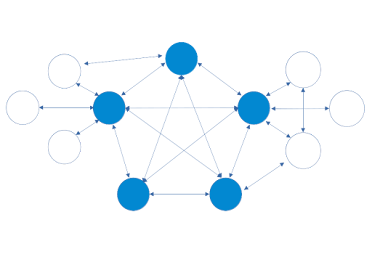CryptoDbSS / Ethereum - Bridge interoperability
a strong scability point is interoperability, How a software can work with
another to increase its functionalities and users, CryptoDbSS has worked hard on
this aspect, that is why Ethereum and its great ecosystem have been kept in
view, one of the most notable is the implementation of its own EVM and smart
contracts, these allow users to program decentralized applications within their
blockchain, and a lot of unimaginable things, this article will demonstrate the
implementation of these through the use of CryptoDbSS own software together with
Ethereum, achieving interoperability between the two.
This package is divided into 3 essential modules,
For a user to be able to use the app, it is necessary to provide a graphical interface, This is served via HTTP, and uses Web3.js to be able to integrate with Metamask, the abi and the smart contract address ethereum is passing by the server for the interaction of user.
The user inputs the CryptoDbSS address and the amount of ETH they wish to transfer to CryptoDbSS, and subsequently presses the connect button.
This module relies on parameter checks at each stage of its execution to ensure all events are indexed correctly and their transactions are subsequently processed. This is maintained even if the application fails or closes unexpectedly. To achieve this, the necessary data is logically stored in the module's database. When the application is reopened, this data is reloaded for continued processing.
Thank you for reading this post. This work has required a great deal of consistency and dedication on my part, and I'm so glad you've made it this far.
suggestions, questions. steenjavier@gmail.com
This package is divided into 3 essential modules,
- the user layer that interacts with the bridge's dapp
- The Ethereum vendor Smart Contract
- the bridge-core engine
Starting from the top, The User Layer.
For a user to be able to use the app, it is necessary to provide a graphical interface, This is served via HTTP, and uses Web3.js to be able to integrate with Metamask, the abi and the smart contract address ethereum is passing by the server for the interaction of user.
The user inputs the CryptoDbSS address and the amount of ETH they wish to transfer to CryptoDbSS, and subsequently presses the connect button.
The following demonstration was performed in Sepolia network (Ethereum testnet) with CryptoDbSS:
deployment of the smart contract on Sepolia at the address
0x4E6CAe59d77FB38D67ee4CeF7fE99c98422581B60x4E6CAe59d77FB38D67ee4CeF7fE99c98422581B6
:)
see on etherscan
see on etherscan
Also included are some Python scripts to manage the smart contract and interact with its functions from the terminal.
This script calls the smart contract's infoAbout() function to display reference information about the contract
The Bridge Core
After the user interacts with the smart contract, the bridge takes responsibility. It reads the events emitted by the smart contract by filtering Ethereum blocks and indexing the relevant elements. These elements contain the CryptoDbSS address and the transferred value provided by the user. Next, the transactions are added to a queue for processing in CryptoDbSS, directed to the specified addresses. Finally, the bridge checks the transaction confirmation to complete its algorithm.This module relies on parameter checks at each stage of its execution to ensure all events are indexed correctly and their transactions are subsequently processed. This is maintained even if the application fails or closes unexpectedly. To achieve this, the necessary data is logically stored in the module's database. When the application is reopened, this data is reloaded for continued processing.
This diagram explains how is based the alhgorithm
Source code Repo at github.com/CryptoDbSS/Eth-bridge
Thank you for reading this post. This work has required a great deal of consistency and dedication on my part, and I'm so glad you've made it this far.
suggestions, questions. steenjavier@gmail.com








